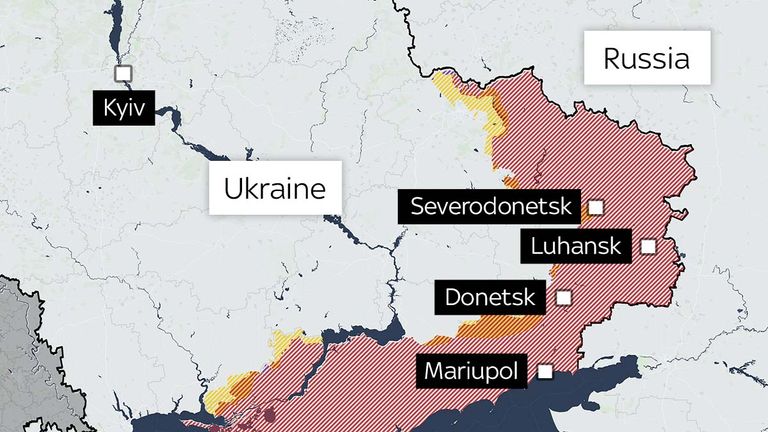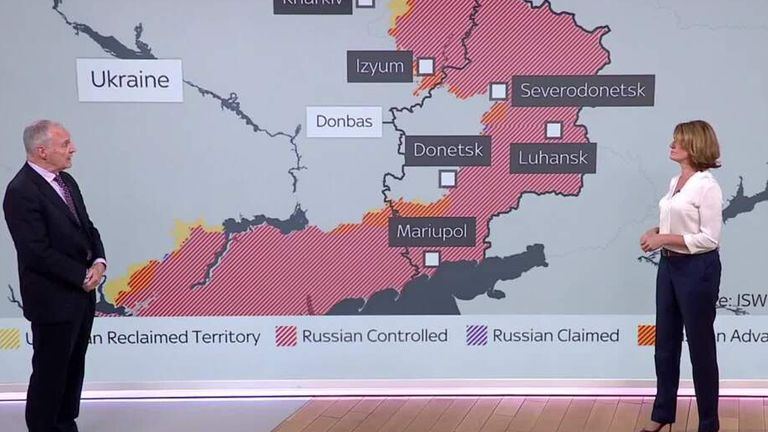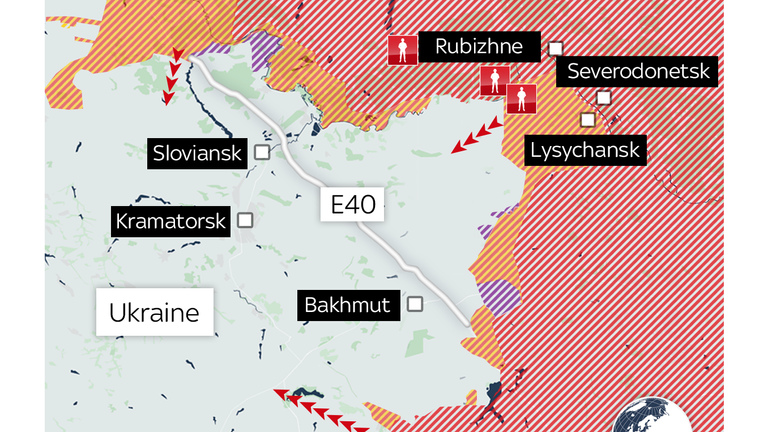Ukraine war: What will happen in the Donbas now Luhansk has fallen to Russia? | World News
Vladimir Putin has declared victory in the eastern Ukrainian region of Luhansk, one day after troops defending it withdrew from the last remaining city in which they were holding out.
It is just under two and a half months since Ukraine‘s President Volodymyr Zelenskyy said the Battle for Donbas – made up of the regions of Luhansk and Donetsk – had begun.
Putin to switch focus after taking key city – live Ukraine updates
How did we get here?
In late April, Sky News spoke to experts who said it was expected that Russia would target villages outside Severodonetsk where Ukraine was mounting its defence.
It was exactly what happened in the following weeks, as Russian forces bombarded Ukrainian positions and pushed the defenders back.
It was believed that the Russians would find resistance tougher to overcome in the towns, as they got bogged down in urban warfare, but the assault on Severodonetsk showed how Moscow intended to achieve its aims.
Experts say Russian forces have adopted a “scorched earth” approach, with heavy artillery being used to pummel Ukrainian positions, in the process destroying anything in their way.
So, if Luhansk has been taken, what next for the Ukraine war?
Read more: Inside Severodonetsk: A city torn apart by war
A break in the fighting?
Vladimir Putin has said military units who fought in Luhansk “should rest, increase their combat capabilities”.
Luhansk’s Ukrainian governor Serhii Haidai said on Monday that the defending forces had retreated from the city to avoid being surrounded. He predicted the Russians will have a much tougher fight on their hands in Donetsk than they had in Luhansk.
Military intelligence expert Forbes McKenzie told Sky News that while Russia had been successful in gaining Luhansk, it had come at a cost.
He said: “They have expended a huge amount of munitions. The UK’s chief of general staff last week told RUSI that 103 combat units have been committed. That is a vast army and the resupply of such would put a strain on any Western NATO country and that’s what the Russians have to do.”
Subscribe to Ukraine War Diaries on Apple Podcasts, Google Podcasts, Spotify, Spreaker
While they have withdrawn from Lysychansk, Mr McKenzie believes it may have been what the Ukrainians intended all along, because it has been so costly for the Russian forces.
He said: “Their intent was to wear down the Russians as best they possibly could, in the pockets around Severodonetsk and Lysychansk. To make the Russians fight.
“There’s no great tactical wins for the Russians other than they get to fly their flag over the rubble of Lysychansk. But they’ve really had to expend men and material in a way they wouldn’t have wanted to.
“So the Ukrainians have achieved that, and they will move to the line between Bakhmut and Sloviansk… [and] will dig in and wait for the Russians to reconstitute and resupply.
“We know the casualty rate is horrific and not really sustainable for both sides, so I think we’ll see an operational pause and for the next couple of weeks.”
Read more: Ukraine war pushes one of Europe’s biggest utility firms to the brink
The front line moves forward
Mr McKenzie said the Ukrainians will have scoped out the land from where they can carry on wearing down the Russian forces.
“The fighting has really got to go to where the combat mass of the Ukrainians are,” he told Sky News. “I would assess it would be the high ground in and around a main road called the E40, that joins Bakhmut up to Sloviansk.
“It’s likely that the Ukrainians want to take a position to the east of that and use the main road for their own supply lines, or take a position to the west of that, on the high ground. And that really creates the new line of defence.
“It remains to be seen whether they’ll trade those two cities for space, or whether they’ll dig in and defend those two cities.
“That’s going to come down to how much Zelenskyy can get his forces up to speed. It takes 120, 180 days to get a fighting brigade into action. So he’s not going to see his fighting brigades in action until another few months, maybe by September.”
Read more: Inside Lysychansk, where all Russia will inherit is rubble
The Russian tactics in reply
Mr McKenzie said for the next six to eight weeks, the Russians are likely to attempt to launch smaller attacks along Ukraine’s defensive line, like those carried out by the Kremlin-linked Wagner Group private army, which is understood to be operating 12km southeast of Bakhmut.
The next full offensive won’t come until later, but any gains will be capitalised on, with an advance being backed up by forces who will follow up a successful operation with an attempt to break through the Ukrainian line.
He said: “The characterisation of an operational pause will just be localised armoured fighting between… a company-sized grouping – three to six tanks, that kind of thing. The next week will let us know if that is the case.
“[You’ll] see probing attacks… up and down the line.
“If we see that for the next six weeks, that indicates the Russians are busy reconstituting their forces.
“If there are pockets of resistance being left behind by the Ukrainians, just to hold up the Russians, then I suspect that there is some intent to do that. The people will be told just expend their munitions, and then rejoin the fighting.
“What has worked relatively well for the Russians is what they call a ‘bypass policy’ – so if they’d not wanted to fight pockets of resistance, they have gone round the back, essentially, cutting the pocket of resistance off. So you may see them making a dash for operational gains on the ground, just going around the Ukrainian defence.”
He said that is likely to result in probing attacks potentially coming from the north, possibly south of Izyum, and the south, for example from the area around the city of Donetsk, where the front lines have not really moved for a long time.
If the Russians make a breakthrough, their strategic aim will be to take the Donbas by the autumn. If they don’t find a way through Ukraine’s defences, the most they will be able to manage will be an all-out assault along a 50km line.
When the rains come, it will make fighting very difficult and then there will be a dramatic fall in temperature, with heavy snow followed by frozen solid ground, none of which makes combat easy. If the battle for Donbas is still being waged in November, the front lines are unlikely to move much through winter, the analyst added.
In addition, Mr McKenzie said the Russians will know they have to achieve their aim before Ukraine is able to bring in NATO supplies and boost their capability.






